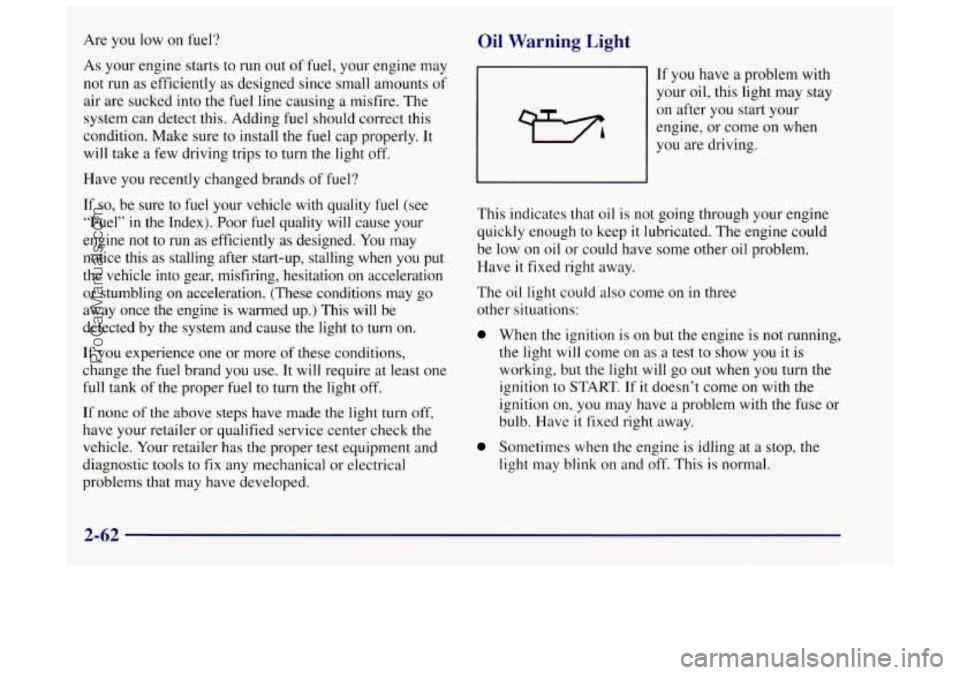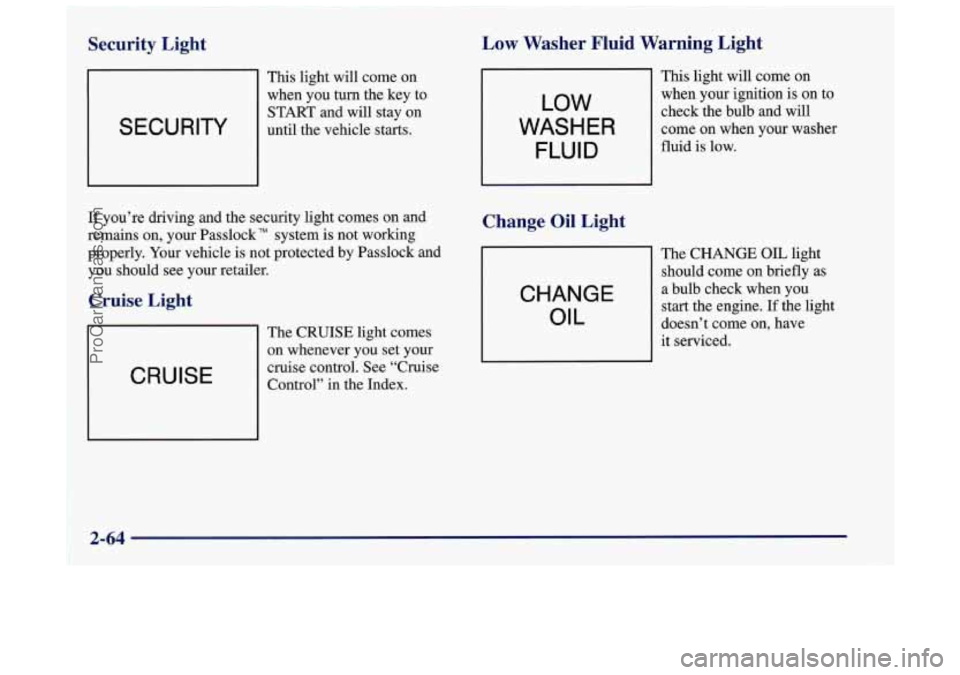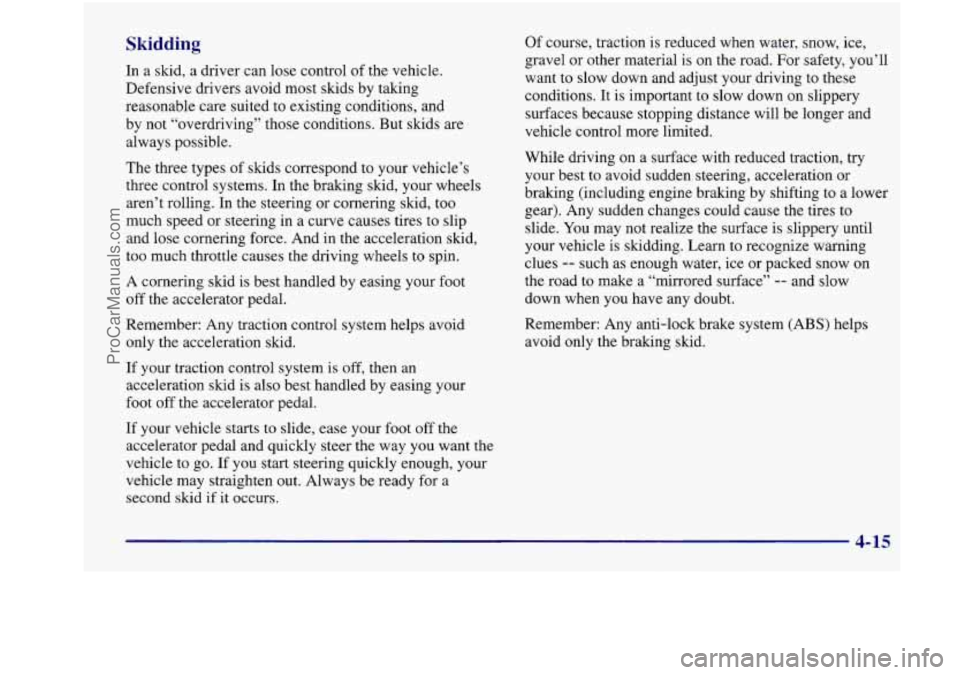warning OLDSMOBILE INTRIGUE 1998 User Guide
[x] Cancel search | Manufacturer: OLDSMOBILE, Model Year: 1998, Model line: INTRIGUE, Model: OLDSMOBILE INTRIGUE 1998Pages: 340, PDF Size: 17.93 MB
Page 118 of 340

Enhanced Traction System Warning Light
(If Equipped)
TRAC
OFF
If the warning light stays
on, or comes on when
you’re driving, there may
be a problem with your
Enhanced Traction System
and your vehicle may
need service. The
Enhanced Traction System warning light may come
on for the following reasons:
e
0
When this warning light is on, the system will not limit
wheel spin. Adjust your driving accordingly.
0
If you turn the system off by pressing the button on
the console, the warning light will come on and stay
on.
To turn the system back on, press the button
again. The warning light should
go off. (See
“Enhanced Traction System” in the Index
for
more information.)
The warning light will come on when you set your
parking brake with the engine running, and it will
stay on if
your parking brake doesn’t release fully. If
the system is turned on and the warning light stays
on after your parking brake is
fully released, it
means there’s a problem with the system.
If the traction control system is affected by an
engine-related problem, the system will turn
off and
the warning light will come on.
If the Enhanced Traction System warning light comes
on and stays on for an extended period
of time when the
system is turned on and the parking brake is fully
released, your vehicle needs service.
2-58
ProCarManuals.com
Page 119 of 340

Low Traction Light
LOW
TRAC
When your anti-lock system
is adjusting brake pressure
to help avoid a braking skid,
this light will come on.
If you have
the Enhanced Traction System, this light will
also come on when the system is limiting wheel spin. You
may feel or hear the system working, but this is normal.
Slippery road conditions may exist if the low traction light
comes on,
so adjust your driving accordingly. The light
will stay
on for a few seconds after the anti-lock system
stops adjusting brake pressure or the Enhanced Traction
System stops limiting wheel spin.
If the light doesn’t come on then, have it fixed so it will
be there to tell you when the anti-lock brake system or
Traction Control System is active.
Slippery road conditions may exist
if the low traction
light comes on,
so adjust your driving accordingly.
Engine Coolant Temperature Gage
\C
You have a gage that shows
the engine coolant
temperature. If
the gage
moves into the red area,
your engine
is too hot.
The low traction light also comes on briefly when you
turn the ignition key to ON. If the light doesn’t come on
then, have
it fixed so it will be there to tell you when the
anti-lock brake system or Enhanced Traction System
is active.
For the optional Traction Control System, the low
traction light comes on briefly when you turn the
ignition to ON. That
reading means the same thing
as the warning light.
It means that your engine coolant has overheated. If you
have been operating your vehicle under normal driving
conditions, you should pull
off the road, stop your
vehicle and
turn off the engine as soon as possible.
In “Problems on the Road,” this manual shows what to
do. See “Engine Overheating” in the Index.
ProCarManuals.com
Page 120 of 340

Low Coolant Warning Light
If this light comes on, your
system is low on coolant
and the engine may
overheat. See “Engine
Coolant” in the Index and
have your vehicle serviced
as soon as you can.
This light will come on briefly when the ignition is
turned to
ON.
Malfunction Indicator Lamp (Service
Engine
Soon Light)
SERVICE
ENGINE
SOON
Your vehicle is equipped
monitors operation
of the
fuel, ignition and emission
control systems.
~ with a computer which This system
is called OBD
I1 (On-Board
Diagnostics-Second Generation) and is intended to assure
that emissions are at acceptable levels for the life of the
vehicle, helping to produce a cleaner environment. The
SERVICE ENGINE SOON light comes on and a chime
will sound to indicate that there is a problem and service
is required. Malfunctions often will be indicated by the
system before any problem is apparent. This may prevent
more serious damage to your vehicle. This system
is also
designed to assist your service technician in correctly
diagnosing any malfunction.
NOTICE:
If you keep driving your vehicle with this light
on, after
a while, your emission controls may not
work as well, your fuel economy may not be as
good and your engine may not run
as smoothly.
This could lead to costly repairs that may not be
covered
by your warranty.
2-60
ProCarManuals.com
Page 122 of 340

Are you low on fuel? Oil Warning Light
As your engine starts to run out of fuel, your engine may
not run as efficiently as designed since small amounts of
air are sucked into the
fuel line causing a misfire. The
system can detect this. Adding fuel should correct this
condition. Make sure to install the
fuel cap properly. It
will take a few driving trips
to turn the light off.
Have
you recently changed brands of fuel?
If
so, be sure to fuel your vehicle with quality fuel (see
“Fuel”
in the Index). Poor fuel quality will cause your
engine not
to run as efficiently as designed. You may
notice this as stalling after start-up, stalling when you put
the vehicle into gear, misfiring, hesitation
on acceleration
or stumbling on acceleration. (These conditions may go
away once the engine is warmed up.) This will be
detected by the system and cause the light to turn on.
If you experience one or more
of these conditions,
change the fuel brand you use. It will require at least one
full tank of the proper fuel to turn the light off.
If none
of the above steps have made the light turn off,
have your retailer
or qualified service center check the
vehicle. Your retailer has the proper test equipment and
diagnostic tools to
fix any mechanical or electrical
problems that may have developed. If
you have a problem with
your oil, this light may stay
on after you start your
engine, or come on when
you are driving.
This indicates that oil is not going through your engine
quickly enough to keep it lubricated. The engine could
be low on oil or could have some other oil problem.
Have
it fixed right away.
The oil light could also come on
in three
other situations:
When the ignition is on but the engine is not running,
the light will come
on as a test to show you it is
working, but
the light will go out when you turn the
ignition to START.
If it doesn’t come on with the
ignition on, you may have a problem with
the fuse or
bulb. Have it fixed right away.
Sometimes when the engine is idling at a stop, the
light may blink on and off. This is normal.
2-62
ProCarManuals.com
Page 124 of 340

Low Washer Fluid Warning Light
Security Light
SECURITY
This light will come on
when you turn the key to
START and will stay on
until the vehicle starts.
LOW
WASHER
FLUID
If you’re driving and the security light comes on and
remains on, your Passlock” system is not working
properly. Your vehicle is not protected by Passlock and
you should see your retailer.
Cruise Light
CRUISE
The CRUISE light comes
on whenever you set your
cruise control. See “Cruise
Control” in the Index.
This light will come on
when your ignition is on to
check
the bulb and will
come on when your washer
fluid
is low.
Change Oil Light
CHANGE
OIL
The CHANGE OIL light
should come on briefly as
a bulb check when you
start the engine.
If the light
doesn’t come
on, have
it serviced.
2-64
ProCarManuals.com
Page 161 of 340

Avoid needless heavy braking. Some people drive in
spurts
-- heavy acceleration followed by heavy braking
-- rather than keeping pace with traffic. This is a
mistake. Your brakes may not have time to cool between
hard stops. Your brakes will wear out much faster if
you do a lot of heavy braking. If you keep pace with the
traffic and allow realistic following distances, you will
eliminate a lot of unnecessary braking. That means
better braking and longer brake life.
If your engine ever stops while you’re driving, brake
normally but don’t pump your brakes.
If you do, the
pedal may get harder to push down. If your engine
stops, you will still have some power brake assist. But
you will use it when you brake. Once the power assist is
used up, it may take longer to
stop and the brake pedal
will be harder
to push.
Anti-Lock Brakes (ABS)
Your vehicle has anti-lock brakes (ABS). ABS is an
advanced electronic braking system that will help
prevent a braking skid.
When you start your engine, or when you begin to drive
away, your anti-lock brake system will check itself. You
may hear
a momentary motor or clicking noise while
this test is going on, and you may even notice that your
brake pedal moves or pulses a little. This is normal.
ANTI -
LOCK
If there’s a problem with
the anti-lock brake system,
this warning light will stay
on or flash. See “Anti-Lock
Brake System Warning
Light” in the Index.
4-7
ProCarManuals.com
Page 164 of 340

When the system is on, this
warning light will come on
to let you know if there’s a
problem with the system.
TRAC
OFF
See “Enhanced Traction System Warning Light’’ in the
Index. When this warning light is on, the system will not
limit wheel spin. Adjust your driving accordingly.
To limit wheel spin, especially in slippery road
conditions, you should always leave the Enhanced
Traction System on. But you can turn the system off if
you ever need
to. (You should turn the system off if your
vehicle ever gets stuck in sand, mud, ice or snow. See
“Rocking Your Vehicle” in the Index.)
To turn the system on
or
off, press the button
on the console.
Your Enhanced Traction System is automatically
activated when you turn the ignition on. This switch
will activate/deactivate the Enhanced Traction System.
If you need to disable the system, such as when you
are stuck and are rocking your vehicle back and forth,
push this switch. See “Stuck:
In Sand, Mud or Snow”
in the Index.
Braking in Emergencies
With anti-lock, you can steer and brake at the same
time. In many emergencies, steering can help you more
than even the very best braking.
4-10
ProCarManuals.com
Page 169 of 340

Skidding
In a skid, a driver can lose control of the vehicle.
Defensive drivers avoid most skids by taking
reasonable care suited
to existing conditions, and
by not “overdriving” those conditions. But skids are
always possible.
The three types of skids correspond to your vehicle’s
three control systems. In the braking skid, your wheels
aren’t rolling. In the steering or cornering skid, too
much speed or steering in a curve causes tires to slip
and lose cornering force. And in the acceleration
skid,
too much throttle causes the driving wheels to spin.
A cornering skid is best handled by easing your foot
off the accelerator pedal.
Remember: Any traction control system helps avoid
only the acceleration skid.
If your traction control system is
off, then an
acceleration skid is
also best handled by easing your
foot off the accelerator pedal.
If your vehicle starts to slide, ease your foot off the
accelerator pedal and quickly steer the way you want the
vehicle to go. If you start steering quickly enough, your
vehicle may straighten out. Always be ready for a
second skid if it occurs. Of
course, traction is reduced when water, snow,
ice,
gravel or other material is on the road. For safety, you’ll
want to slow down and adjust
your driving to these
conditions. It is important to slow down on slippery
surfaces because stopping distance will be longer and
vehicle control more limited.
While driving on a surface with reduced traction, try
your best to avoid sudden steering, acceleration or
braking (including engine braking by shifting to a lower
gear). Any sudden changes could cause the tires to
slide. You may not realize the surface is slippery until
your vehicle is skidding. Learn to recognize warning
clues
-- such as enough water, ice or packed snow on
the road to make a “mirrored surface”
-- and slow
down when you have any doubt.
Remember: Any anti-lock brake system (ABS) helps
avoid only the braking skid.
4-15
ProCarManuals.com
Page 174 of 340

City Driving Here are ways to increase your safety in city driving:
Know the best way to get to where you are
going. Get a city map and plan your trip into an
unknown part of the city just as you would for a
cross-country trip.
Try to use the freeways that rim and crisscross
most large cities. You’ll save time and energy.
(See the next part, “Freeway Driving.”)
0 Treat a green light as a warning signal. A traffic
light is there because the corner is busy enough to
need
it. When a light turns green, and just before you
start to move, check both ways for vehicles that have
not cleared the intersection or may be running the
red light.
One of the biggest problems with city streets is the
amount
of traffic on them. You’ll want to watch out for
what the other drivers are doing and pay attention
to
traffic signals.
4-20
ProCarManuals.com
Page 179 of 340

Winter Driving
Here are some tips for winter driving:
Have your vehicle in good shape for winter.
You may want to put winter emergency supplies in
your trunk. Include an
ice scraper,
a small brush or broom, a supply
of windshield washer fluid, a rag, some winter outer
clothing, a small shovel, a flashlight, a red cloth and a
couple of reflective warning triangles. And, if you will
be driving under severe conditions, include a small bag
of sand, a piece of old carpet or a couple of burlap bags
to help provide traction. Be sure you properly secure
these items in your vehicle.
4-25
ProCarManuals.com